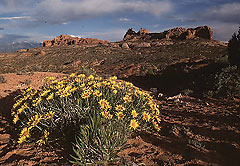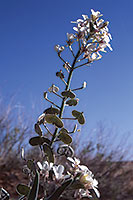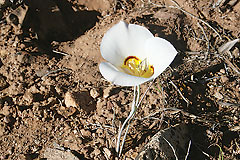It’s all about the moisture. Winter snows and spring rains and autumn thunderstorms. The best storms are those that bring gentle, steady rains which the ground soaks up like a long lost friend. Deluges tend to saturate the ground quickly, creating an impenetrable barrier that forces the rest of the rainfall to slide downstream. 
In this land of little rain, any moisture is welcomed by those who live here. Particularly the plants, whose roots restrict their movement. Throw in saline soils or soils created from the erosion of sandstone, yes, only the fit survive here.
On top of moisture and soil conditions, throw in temperate ranges from below 0° F to over 100°F. Plants that can’t take the temperature or prolonged drought don’t grow here.
Many desert plants have waxy coatings on their leaves to prevent moisture loss to the atmosphere or to minimize desiccation. Like a savvy stock broker, these plants know when to cut their losses, shedding leaves during drought to maintain their survival. These plants also have efficient root systems that draw moisture from the soil before it is lost to evaporation.
 Hardy shrubs and slow-growing trees characterize this desert landscape. Blackbrush, bitterbrush, sagebrush - these shrubs dominate different habitats and survive the years with slow growth and conserving their resources. But in the spring, when the desert awakens with a palette of color, these hardy shrubs are ignored for the more splashy and flashy wildflowers that take advantage of the seasonal rains.
Hardy shrubs and slow-growing trees characterize this desert landscape. Blackbrush, bitterbrush, sagebrush - these shrubs dominate different habitats and survive the years with slow growth and conserving their resources. But in the spring, when the desert awakens with a palette of color, these hardy shrubs are ignored for the more splashy and flashy wildflowers that take advantage of the seasonal rains.
Like birds, some wildflowers bloom in flocks – profusions of beeplant or scorpionweed carpet the desert. Small beautiful wild onions or unusual bifocal fruits of spectacle-pod seemingly erupt from the ground in vast quantities. Displays of sego lilies, the Utah State Flower, grace hillsides and valley floors where it seems nothing should grow. Their bright white petals hide their inner beauty designed to assist pollinators with their task ahead.
Where there isn’t a swath of color spreading across the desert, there are more solitary species growing in a variety of places. These plants have spread their seeds farther away and entice pollinators with bright flowers, nectar rewards or pollen for the taking.
 Sand verbena, rough mule’s ears, butterfly milkweed, Indian paintbrush and Eaton’s penstemon are just a few of these spectacular wildflowers that dot the landscape. The mule’s ears are more shrub-like due to its size, but the others are delicate and embody the fragile and wild and resilient spirit of a desert wildflower.
Sand verbena, rough mule’s ears, butterfly milkweed, Indian paintbrush and Eaton’s penstemon are just a few of these spectacular wildflowers that dot the landscape. The mule’s ears are more shrub-like due to its size, but the others are delicate and embody the fragile and wild and resilient spirit of a desert wildflower.
Just as tough, there are other wildflowers that only grow in moist sites such as springs and seeps. Red monkeyflowers hang from rock alcoves, their roots penetrating the flaky recesses of the seep. Easter flowers bloom in early spring around the time of Easter, and grow only in these hidden oases.
So as winter gives way to spring and the season of wildflowers erupts, take care where you tread – these plants have survived some challenging conditions and trampling them would be a shame. Enjoy their beauty and uniqueness and the swipe of color they leave across the landscape. Like Luther Burbank said, “Flowers always make people better, happier, and more helpful; they are sunshine, food and medicine for the soul.”